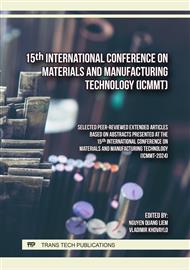p.3
p.9
p.17
p.23
p.31
p.39
p.45
p.51
Influence of Silicon Carbide Incorporation on Thermal and Ablation Properties of Carbon Fabric-Phenolic Resin Composites
Abstract:
To shield re-entry spacecraft from the extreme heat experienced during hypersonic flight through a planet's or the earth's atmosphere, thermal protection systems (TPS) were developed. This work involved the fabrication of composites using a polyacrylonitrile (PAN) based carbon fabric (Cf)-phenolic resin matrix (PR) modified with different weight percentages (wt.%) of silicon carbide (SiC), namely 0 wt.% (Cf/PR), 1wt.%, 3wt.%, and 5wt.%. The composites were prepared using the hydraulic hot press method. The manufactured composites were analyzed for their thermal conductivity and resistance to ablation using an oxyacetylene torch test. Furthermore, the ablated composites underwent X-ray diffraction (XRD), revealing a SiO2 compound layer on the ablated composite surface. The experimental results demonstrated that the Cf/PR composites modified with 3wt.% of SiC exhibited superior characteristics. The composites consist of 3wt.% Cf/PR-SiC exhibited a thermal conductivity value of 0.57 W/m K. Additionally, these composites showed a noticeable decrease in the mass ablation rate (MAR) at 0.0052 mm/sec and linear ablation rates (LAR) at 0.025061 gm/sec. This study proposed an effective way to improve the thermal and ablation characteristics of TPS materials.
Info:
Periodical:
Pages:
9-14
Citation:
Online since:
October 2024
Authors:
Price:
Сopyright:
© 2024 Trans Tech Publications Ltd. All Rights Reserved
Share:
Citation:



